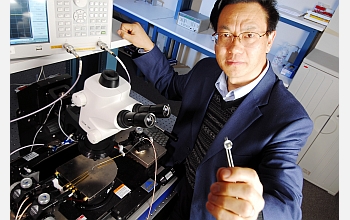|

Press Release 07-036
Minuscule Generators Convert Motion Into Nanoscale Electricity Source

Energy from tiny movements, ultrasound waves and even bloodflow can charge the devices
April 5, 2007
In a breakthrough that could free nanomachines from the bulk of batteries, researchers have developed a novel nanogenerator--an array of tiny filaments that converts the smallest motions into electrical current.
The nanowires are crafted from zinc oxide, a safe material that would allow the generator to be used in biomedical applications, and may eventually power nanomotors, tiny sensors, and if in large enough arrays, macroscale devices.
Georgia Institute of Technology engineer Zhong Lin Wang and his colleagues announce the development in the Apr. 6 issue of Science.
The researchers developed the generators with the support of the National Science Foundation, the Defense Advanced Research Projects Agency and the Emory-Georgia Tech Nanotechnology Center for Personalized and Predictive Oncology.
Additional information is available in the Georgia Tech press release at http://www.gatech.edu/news-room/release.php?id=1326
The research was supported by the NSF Metals Program in the Division of Materials Research through award DMR 9733160.
-NSF-

Media Contacts
Joshua A. Chamot, NSF (703) 292-7730 jchamot@nsf.gov
John Toon, Georgia Institute of Technology (404) 894-6986 john.toon@innovate.gatech.edu
Program Contacts
Harsh Deep Chopra, NSF (703) 292-4543 hchopra@nsf.gov
Principal Investigators
Zhong Lin Wang, Georgia Institute of Technology (404) 894-8008 zhong.wang@mse.gatech.edu

The National Science Foundation (NSF) is an independent federal agency that supports fundamental research and education across all fields of science and engineering. In fiscal year (FY) 2009, its budget is $9.5 billion, which includes $3.0 billion provided through the American Recovery and Reinvestment Act. NSF funds reach all 50 states through grants to over 1,900 universities and institutions. Each year, NSF receives about 44,400 competitive requests for funding, and makes over 11,500 new funding awards. NSF also awards over $400 million in professional and service contracts yearly.
 Get News Updates by Email Get News Updates by Email
Useful NSF Web Sites:
NSF Home Page: http://www.nsf.gov
NSF News: http://www.nsf.gov/news/
For the News Media: http://www.nsf.gov/news/newsroom.jsp
Science and Engineering Statistics: http://www.nsf.gov/statistics/
Awards Searches: http://www.nsf.gov/awardsearch/
| 



